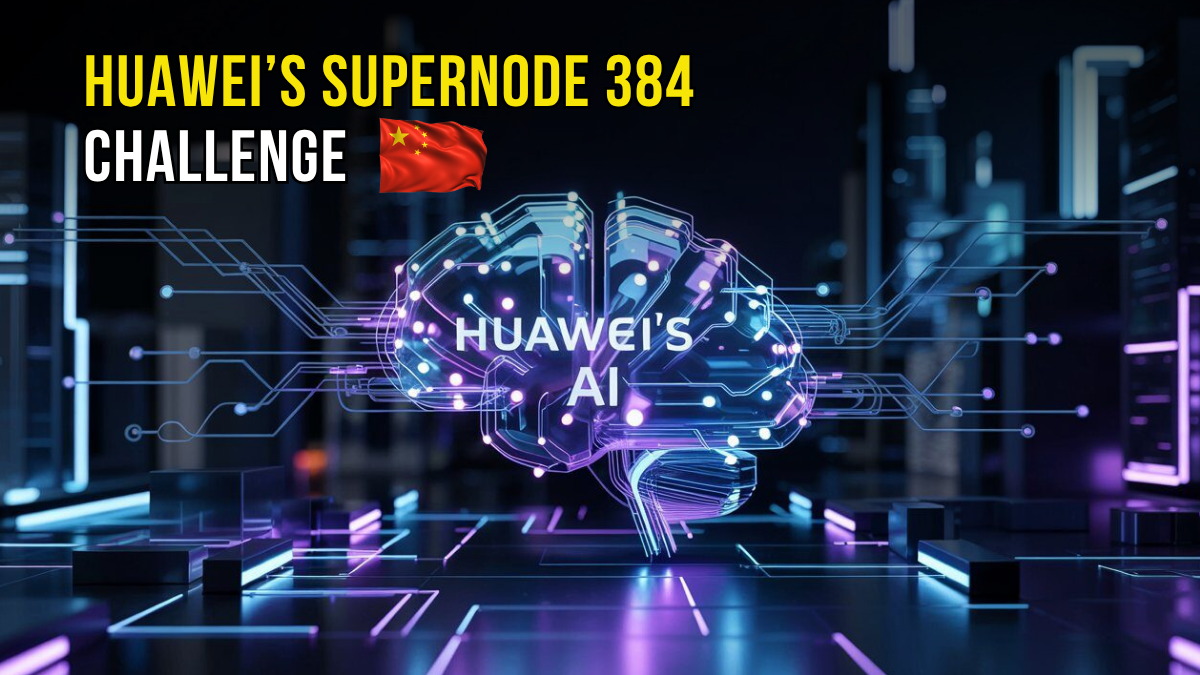The world of AI computing has long been dominated by Nvidia, a powerhouse in the development of high-performance processors designed for AI-driven workloads. However, Huawei has entered the scene with its groundbreaking Supernode 384 architecture, a development that could disrupt Nvidia’s stronghold on the market. This blog explores how Huawei’s Supernode 384 is challenging the status quo, pushing boundaries in AI computing, and what it means for the future of technology.

What is Huawei’s Supernode 384?
Huawei’s Supernode 384 is a peer-to-peer computing architecture tailored for AI applications requiring massive parallel processing. Moving away from traditional server frameworks, the system is specifically designed to support next-generation AI workloads, including Mixture-of-Experts (MoE) models, which demand advanced computational efficiency.
Core Features:
- 384 Ascend AI Processors across 12 compute and 4 bus cabinets.
- 300 petaflops of computing power for unparalleled performance.
- 48TB of high-bandwidth memory for smooth communication and data transfer.
- Optimized for dense AI models and applications requiring high-speed communication.
Performance Metrics and Industry Benchmarks
One of the most compelling aspects of the Supernode 384 is its performance. Benchmark testing reveals its capability to outperform traditional AI cluster systems.
Key Metrics Include:
- 2.5x Faster Performance: Models like Meta’s LLaMA 3 achieve 132 tokens per second per card, significantly surpassing conventional systems.
- Higher Efficiency in Communication-Heavy Applications: For models such as Alibaba’s Qwen, Supernode 384 clocks 600–750 tokens per second per card.
- Reduced Latency: Huawei eliminated conventional Ethernet interconnects in favor of high-speed bus connections, lowering latency from 2 microseconds to an impressive 200 nanoseconds.
This improved communication enables the Supernode 384 to function as a unified computing entity, offering exceptional scalability and efficiency.
Breaking Free from the Von Neumann Model
A key innovation of Huawei’s Supernode 384 lies in its departure from the legacy Von Neumann architecture. This older configuration, which separates processing, memory, and data transfer, has become a bottleneck for parallel AI workloads requiring scalability.
Huawei’s peer-to-peer architecture directly tackles these issues, making the Supernode 384 ideal for advanced AI models like MoE that rely on multiple specialized sub-networks.
Geopolitical Context
The development of Supernode 384 is deeply linked to escalating US-China tech tensions. American sanctions have restricted Huawei’s access to state-of-the-art semiconductor technology. Instead of stalling innovation, these constraints have forced Huawei to explore novel solutions.
How Huawei is Innovating Under Sanctions:
- Architecture Over Individual Components: While Huawei’s Ascend 910C processor may lag behind cutting-edge US chips, the system as a whole achieves superior performance due to its innovative design.
- Focused Development: Huawei has shifted its investments toward integrated systems, prioritizing architectural innovation over isolated chip advancements.
This approach is reshaping global AI infrastructure, simultaneously challenging Nvidia and decentralizing the global supply chain.
Implications for the AI Industry
Huawei’s Supernode 384 has far-reaching implications for industries and businesses operating in the AI landscape.
Scalability Advantages:
The system’s ability to connect tens of thousands of processors creates opportunities for training larger and more complex AI models. Sectors such as finance, healthcare, and advanced manufacturing stand to benefit from this scalable infrastructure.
Competitive Dynamics:
Nvidia’s dominance forces most organizations to remain reliant on a single supplier. Huawei’s alternative solution offers a new player in this otherwise highly consolidated market.
Technological Fragmentation:
The geopolitical backdrop highlights the risks of fragmentation in the global technology ecosystem. Huawei’s solutions may appeal to markets less aligned with US-led supply chains, potentially fueling further regional segmentation.
Real-World Deployment
Huawei has already operationalized the Supernode 384 in multiple Chinese data centers, including locations in Anhui, Inner Mongolia, and Guizhou provinces. These practical deployments underscore the viability of the system and signal Huawei’s readiness to scale its AI infrastructure globally.
What’s Next for Huawei and Nvidia?
While the Supernode 384 demonstrates Huawei’s ability to build competitive, large-scale AI systems, its long-term success will hinge on ecosystem adoption and sustained innovation. Nvidia, on the other hand, remains a leader in chip manufacturing and software integration, giving it a strategic edge.
For businesses evaluating their next AI investments, Huawei’s Supernode 384 marks an exciting new alternative worthy of consideration. However, navigating the fragmented tech landscape will require balancing performance needs with geopolitical realities.
FAQs: Frequently Asked Questions
Q. What is Huawei Supernode 384?
A. Huawei Supernode 384 is an advanced computing architecture designed to challenge existing AI hardware solutions. It boasts high-performance capabilities optimized for AI workloads.
Q. How does it compare to Nvidia’s offerings?
A. The Supernode 384 offers a competitive alternative to Nvidia’s products by focusing on improved energy efficiency, scalability, and cost-effectiveness for AI-driven applications.
Q. What industries can benefit from Huawei’s Supernode 384?
A. Industries such as healthcare, finance, autonomous vehicles, and any sector requiring high computational power for AI models can leverage the advantages of the Supernode 384.
Q. Are there any geopolitical concerns with adopting this technology?
A. Given Huawei’s background and the current technological landscape, geopolitical considerations such as export restrictions or vendor neutrality might influence adoption decisions.
Q. Is the Supernode 384 widely available?
A. Availability may vary by region, with distribution potentially influenced by existing trade regulations and partnerships. Businesses are advised to consult Huawei’s official channels for up-to-date information.
Click HERE For More
